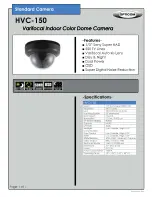
DSP-19 User Manual
Page 8 of 24
DSP19_MAN_A
3.
Features and Functions
Solid-State Output
The DSP-19 has one solid-state (open-drain) output. Solid-state outputs have several advantages over relay
outputs:
•
Allows for a smaller form factor
•
Lower power consumption
•
Outputs do not have to be debounced (relay contact bounce when closing)
•
Higher reliability due to no moving parts
But they also have their limitations:
•
Requires that the detector and the operator have the same DC common
•
Requires a pull-up resistor to function correctly
•
The output can only be pulled down to DC common (can only sink current)
•
Limited current switching capability (250 milliamps)
•
Polarity sensitive (will not work if connected backwards)
With proper engineering these limitations can be easily overcome and the benefits of the solid-state output can
be fully realized. Almost all operators are now designed to share their DC common with external devices and have
built in pull-up resistors on their inputs to facilitate working with solid-state (open-collector) outputs. These inputs
usually require less than 20 milliamps of current sinking capability to be activated.
The polarity issue is handled by the operator if the detector plugs directly in to the operator. If using an adapter
board like the RK-1 or RK-3, the negative side of the output is already connected to DC common. So the output is
simply connected to the desired termination point on the controller and it should all work.
The easiest way to envision the function of a solid-state (open-drain) output is to think of it as a normally open
relay contact with the relay common connected to DC common.
Detector Reset
When any of the DIP switches or the 10-position rotary switch is changed, or power is cycled to the detector, the
detector will perform a reset. The reset event will last for two seconds while the detector initiates any changes
and waits for all systems to stabilize.
NOTE:
If a vehicle is over the loop during the reset period it will not be
detected.
Both LEDs will turn off for 500 milliseconds at the start of the reset event. After that, the red LED will flash
according to its fail-safe or fail-secure mode of operation. A flash rate that is the same as the power LED indicates
the output is operating as fail-safe. A much faster flash rate indicates that the output is operating in the fail-secure
mode.
When a failure occurs, the output will be active if the detector is in the fail-safe mode. It will be inactive if in fail-
secure.









































